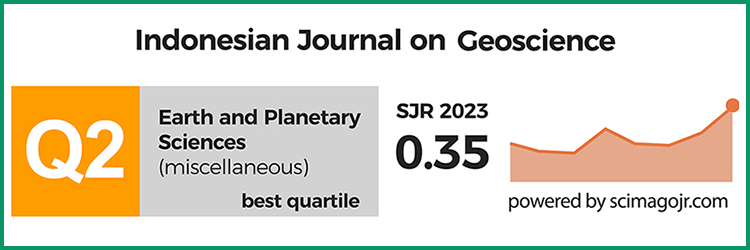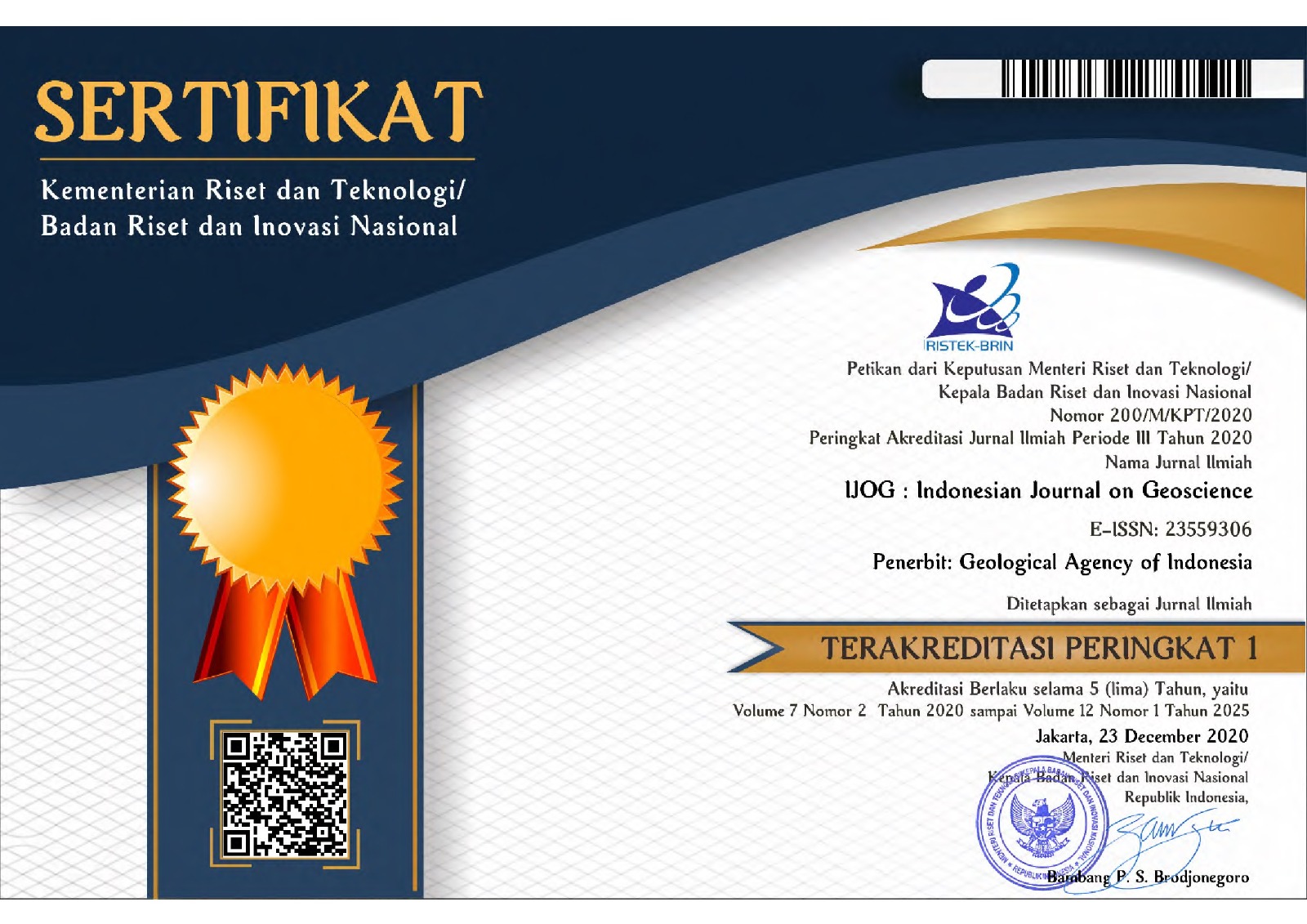Tectonic Control on the Formation of Cleats in the Coal Beds of the Sajau Formation, Berau Basin, Northeast Kalimantan
DOI:
https://doi.org/10.17014/ijog.5.3.235-250Keywords:
Pliocene, coal, Sajau Formation, cleat, Berau BasinAbstract
DOI: 10.17014/ijog.5.3.235-250
Coal seams of lignite- to subbituminous rank of Pliocene-age from the Sajau Formation of the Berau Basin are characterized by the presence of a natural fracture system, including cleats. Often, these opening-mode fractures consist of two orthogonal sets (face and butt cleats), both almost perpendicular to the bedding. This paper describes the distribution of orientation, spacing, and aperture of cleats formed in the seams of the Sajau Formation. All observations and measurements were conducted at macroscopic, mesoscopic, and microscopic scales. The butt cleat mean orientations are NE-SW and NW-SE, whereas the face cleat mean orientations are NNE-SSW and NE-SE, and the cleat dip is at a high angle of 75° to the north. The angles between the orientations of these cleat sets are nearly 90°; that is, they are orthogonal. The spacing of the macroface cleats is between 9.52 and 14.46 cm (averaging 11.61 cm), while the spacing of the butt cleats is between 2.3 and 11.3 cm (averaging 5.35 cm). The mean aperture is 0.54 mm. In contrast, the mean spacing of the mesoface cleats is 3.09 mm, and the aperture measurements of these cleats range from 0.0478 to 0.0741 mm (averaging 0.0549 mm). The results obtained from outcrops and X-ray CT (computed tomography) scan clearly indicate that the NNE-SSW face cleat orientations are strictly parallel to the elongation of the main tectonic structures in the studied area. Their origin may be explained by their relationship with local tectonic stress (the maximum principal stress, σ1, was horizontal). Partial least square analysis of data collected from cleats and faults in the area indicates that a power law distribution exists between the cleat characteristics (spacing, density, and aperture), and the distance of the faults (R2 = 0.56). Cleat formation in the Sajau Formation was mainly controlled by the mechanical response to tectonic stresses, which generated a unique cleat network in the coal. Based on the SEM photography, it is concluded that the development of microcleats in the Sajau Formation resulted from both endogenic processes and tectonic activities as indicated by the change in the shape of the cleats, from straight line to curved shape and branching (intersection of multiple cleats that form a conical network at the end).
References
Ammosov, I.I. and Eremin, I.V., 1963. Fracturing in Coal. IZDAT Publishers, Moscow. Office of Technical Services, U.S. Department of Commerce, Washington, DC. 109pp.
ARII (Advanced Resources International Inc.), 2003. Indonesia CBM Data Package, Advanced Resources International, Inc. Migas and ADB Report: www.adv-res.com.
Ayers, W. B., 2002. Coalbed gas system, resources, and production and a review of contrasting cases from the San Juan and Powder River basins. American Association of Petroleum Geologists Bulletin, 86 (11), p.1853-1890. DOI: 10.1306/61eeddaa-173e-11d7-8645000102c1865d
Close, J., 1993. Natural fractures in coal. In: Law, B.E., Rice, D.D. (eds), Hydrocarbons from Coal. AAPG Studies in Geology, 38, p.119-132.
Flores, R.M., 2013. Coal and Coalbed gas: Fueling the Future. Elsevier, Waltham, MA. 697pp.
Hamdani, A.H., 2015. X-ray Computed Tomography Analysis of Sajau Coals, Berau Basin, Indonesia: 3D Imaging of Cleat and Microcleat Characteristics. International Journal of Geophysics,
p.1-8. DOI: 10.1155/2015/415769
Karacan, C.Ö. and Okandan, E., 2000. Fracture/cleat analysis of coals from Zonguldak Basin (northwestern Turkey) relative to the potential of coalbed methane production. International Journal of Coal Geology, 44, p.109-125. DOI:10.1016/s0166-5162(00)00004-5
Ketcham, R.A., Slottke, D.T., and Sharp, M.,2010. Three-dimensional measurement of fractures in heterogeneous materials using high-resolution X-ray computed tomography. Geosphere, 6 (5), p.499-514. DOI: 10.1130/ges00552.1
Laubach, S.E., 1991. Fracture patterns in lowpermeability
sandstone gas reservoir rocks in the Rocky Mountain region. Proceedings, Joint Society of Petroleum Engineers Rocky Mountain Regional Meeting. Low-Permeability Reservoir Symposium SPE Paper, 21853, Society of Petroleum Engineers, Richardson, Tex. DOI: 10.2118/21853-ms
Laubach, S.E., Tyler, R., Ambrose, W.A., Tremain, C.M., and Grout, M.A., 1992. Preliminary map of fracture patterns in coal in the western United States. Geological Association, Wyoming, 43, p.253-267.
Laubach, S.E., Marrett, R.A., Olson, J.E., and Scott, A.R., 1998. Characteristics and origins of coal cleat: a review. International Journal of Coal Geology, 35, p.175-207.
Lentini, M.R. and Darman, H., 1996. Aspects of the Neogene Tectonic History and Hydrocarbon Geology of the Tarakan Basin, Proceedings, Indonesian Petroleum Association, 27th Annual Convention, p.241-25.
Lohmőller, J.B., 1989. LVPLS 1.6 program manual: Latent variables path analysis with partialleast square estimation. Munich, Germany: University of the Federal Armed Forces.
Pahl, P.J., 1981. Estimating the mean length of discontinuity traces. Internation Journal of Rock Mechanics and Mining Sciences, 18, p.221-228.
Paul, S. and Chatterjee, R., 2011. Determination of in-situ stress direction from cleat orientation mapping for coal bed methane exploration in south-eastern part of Jharia coalfield, India,
International Journal of Coal Geology, 87(2), p.87-96. DOI: 10.1016/j.coal.2011.05.003
Pollard, D. D. and Aydin, A., 1988. Progress in understanding jointing over the past century. Geological Society of America, Bulletin, 100, p.1181-120.
Priest, S.D., 1993. Discontinuity Analysis for Rock Engineering. Chapman & Hall, London, United Kingdom.
Rodrigues C. F., Laiginhas, C., Fernandes, M., Lemos de Sousa, M.J., and Dinis, M.A.P., 2014. The coal cleat system: A new approach to its study. Journal of Rock Mechanics and
Geotechnical Engineering, 6, p.208-218. DOI:10.1016/j.jrmge.2014.03.005
Salahuddin , Setianto A., Rakhmadi A, and Jonathan, 2011. Geological Evolution of the Berau sub-Basin, East Kalimantan.
Scott, S., Anderson, B., Crosdale, P., Dingwal, J., and Leblang, C., 2007. Coal petrology and coal seam gas contents of the Walloon Subgroup-Surat Basin, Queensland, Australia. International Journal of Coal Geology, 70, p.209-222. DOI: 10.1016/j.coal.2006.04.010
Situmorang, R.L. and Burhan, G., 1995. Geological Map of the Tanjungredeb Quadrangle, Kalimantan, scale 1:250.000. Geological Research and Development Centre, Bandung.
Songhang, Z., Shuheng, T., Dazhen, T., Zhejun P., and Fang, Y., 2010, The characteristics of coal reservoir pores and coal facies in Liulin district, Hedong coal field of China. International
Journal of Coal Geology, 83, p.117-127. DOI: 10.1016/j.coal.2009.11.007
Su, X., Feng, Y., Chen, J., and Pan, J., 2001. The characteristics and origins of cleat in coal from Western North China. International Journal of Coal Geology, 47, p.51-62. DOI: 10.1016/
S0166-5162(01)00026-X
Ting, F.T.C., 1977. Origin and spacing of cleats in coal beds. Journal of Pressure Vessel Technology Transaction. ASME, 99, p.624-626.
Tremain, C.M, Laubach, S.E., and Whitehead, III N.H., 1991. Coal fracture (cleat) patterns in Upper Cretaceous Fruitland formation, San Juan Basin, Colorado and New Mexicoimplications
for coalbed methane exploration and development. In: Schwochow, S, Murray D.K., and Fahy M.F. (eds.), Coalbed Methane of Western North America. Rocky Mountain Association of Geologists, p.49-59. DOI: 10.23867/ri2018d
Wellington, S.L. and Vinegar, H.J., 1987. X-ray computerized tomography. Journal of Petroleum Technology, 39, p.885-898.
Wold, H., 1982. Soft modeling: the basic design and some extensions. In: Jöreskog K.G. and Wold, H. (eds.), Systems under Indirect Observation, Part 2. North-Holland, p.1-5.
Wold, H., 1985. "Partial Least Squares", In: Kotz, S. and Johnson, N. L. (eds.), Encyclopedia of Statistical Sciences (6), New York, Wiley, p.581-591.
Xu, H., Tang, D. Z., Liu, D.M., Tang, S.H., Yang, F., Chen, X.Z., He, W., and Deng, C.M., 2012. Study on coalbed methane accumulation characteristics and favorable areas in the Binchang
area, southwestern Ordos Basin, China. International Journal of Coal Geology, 95, p.1-11. DOI: 10.1016/j.coal.2012.02.001
Yanbin, Y., Dameng, L., and Yongkai, Q., 2013, Variable gas content, saturation, and accumulation characteristics of Weibei coalbed methane pilot-production field in the southeastern Ordos
Basin, China. American Association of Petroleum Geologist, Bulletin, 97 (8), p.1371-1393. DOI: 10.1306/02131312123



















